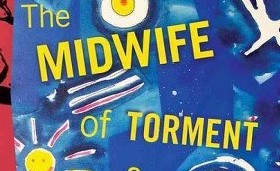
The Midwife of Torment
Paulo Da Costa
Guernica Editions
Review by Jessica Barratt
Weaving many flash-fiction works into a single, bound narrative, Paulo Da Costa’s The Midwife of Torment paints humanity in its honest bright colours and oscillating emotions of anger, anguish, terror, and curiosity. Between the pages of these sudden fictions lies the nuance of our everyday existence, filtered through Da Costa’s own internal struggle concerning his simultaneous anger and affection for modern humanity. Closing with a solution for readers who face the same conflict, Da Costa’s Midwife paradoxically uses difference to reveal the commonalities between us all.
Organized into sections that act as “chapters” for each grouping of flash- or micro-fictions – never exceeding 1000 words – Midwife depicts a vast array of characters bearing an equally diverse set of strange and sometimes grotesque perspectives. At one moment, a story will speak to the intensely flawed nature of human existence, and in the next it will depict life’s beauty and human goodness. Take for instance the dichotomy between “the God of Shadows” and “Grandpa,” two opposing characters who appear literally at either end of the novel. While the former carries within them a putrid hatred for human sloth, the other embraces the kind of slowness that engenders appreciation for the little things. Between these two, a fragile equilibrium exists. Their reflections as they relate to time are opposed, yet balanced.
In much the same way, the work’s full title, The Midwife of Torment, can be described as harmonizing strength against pain: Life against torture. Looked at this way, one might say that Da Costa is trying to come to terms with conflict as it exists within each of us. He is attempting to explore the wild forces that control us every day. Naturally, one of Da Costa’s sections is titled “Force” and portrays characters who choose to resist social norms in ways that others find upsetting.
From this point, the standout feature of Da Costa’s work reveals itself between the lines. Yes, amid the detailed faces of each wily character, Da Costa weaves another, unified story—the tale of an author who has seen into the darkest corners of humanity and who found hatred and hope sleeping there together. Inspired, he has housed these strong oppositional forces within an individual body (i.e. the book), thereby reminding himself and readers of an often-forgotten truth regarding our human condition: that we, too, contain a vast range of contrasting perspectives in ourselves, but require every flaw, every mistake, every dark corner to be whole. In a sense, this philosophical perspective results in the further realization that these differences are what binds all of humanity.
Intensely vulnerable, Da Costa thus chooses to showcase an imperfect and flawed emotional cast to his own benefit, and ultimately succeeds in taking a risk with his work’s unusual form. In showing his readership how he manages the highs and lows of his own worldview, I believe readers will come away from Da Costa’s work feeling surer of themselves, and more delicately aware of the chaos of existence. At least for Da Costa, it is a chaos that always, somehow, finds its way to unity.
Jessica Barratt is an aspiring novelist and freelance editor currently working on her first full-length manuscript tentatively titled, Domingo. Jessica’s work has been published in magazines such as Invest in Alberta, The Yards, and The Wanderer, and her self-managed editing company JB Editing has found much success in meeting the creative and professional needs of its clients. To learn more about Jessica, visit www.wordsofhers.com.